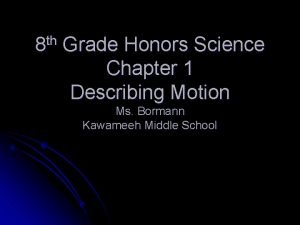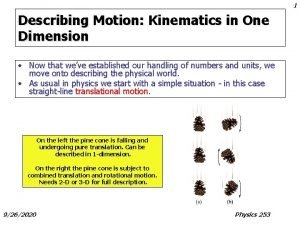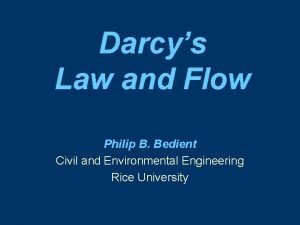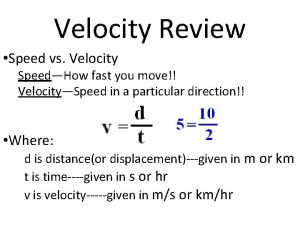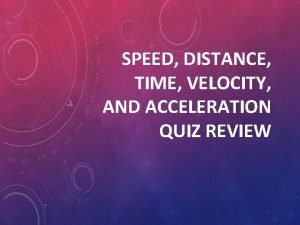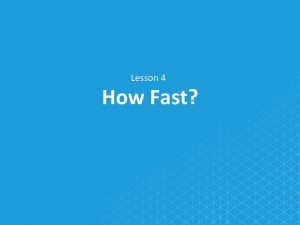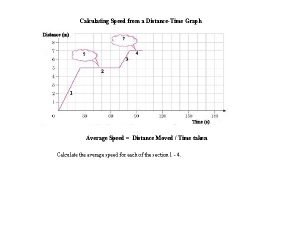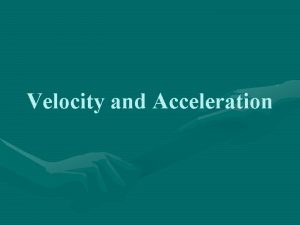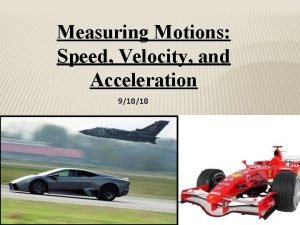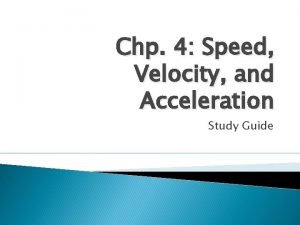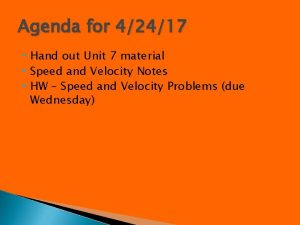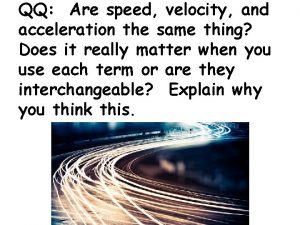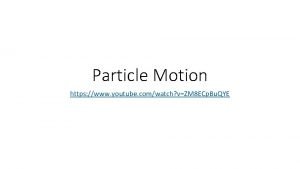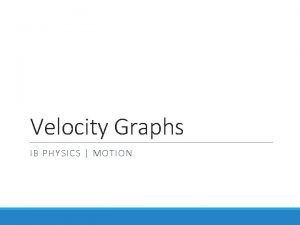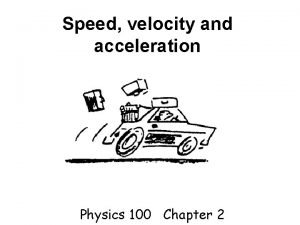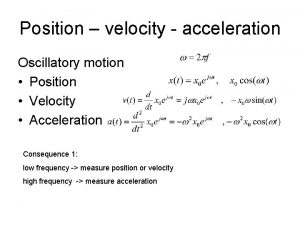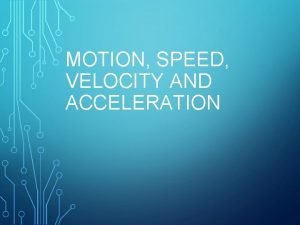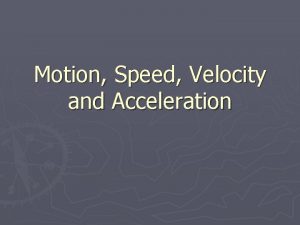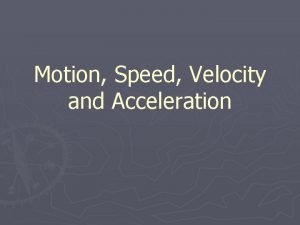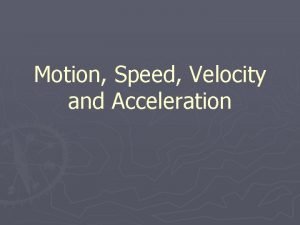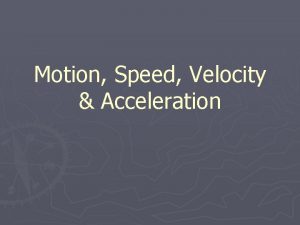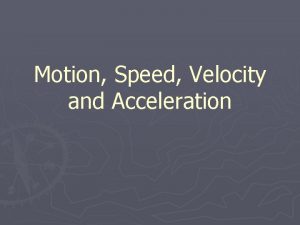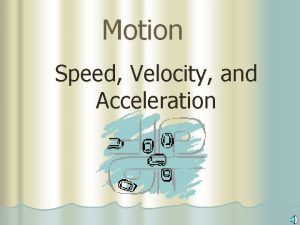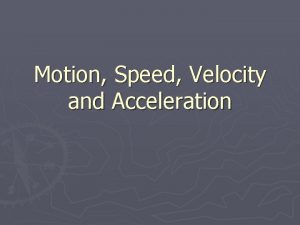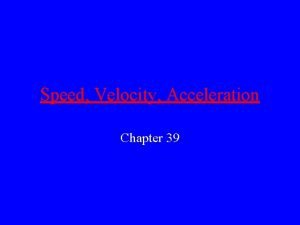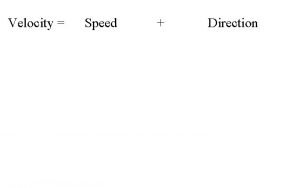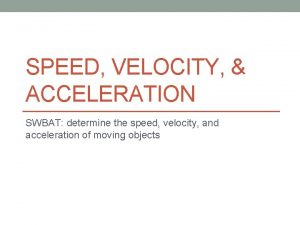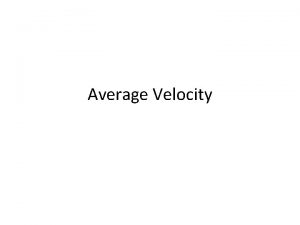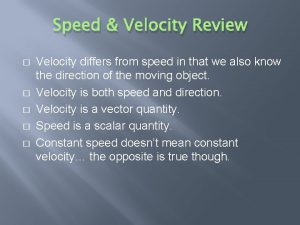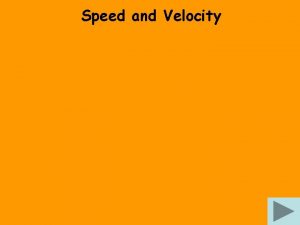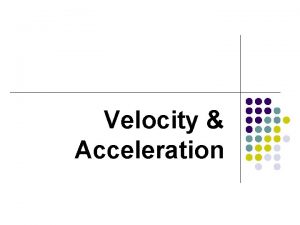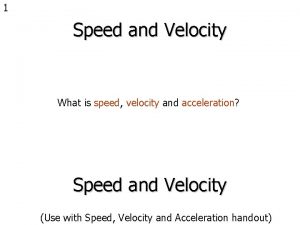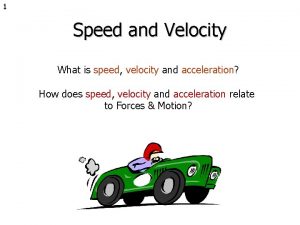CHAPTER 4 MOTION 4 1 POSITION SPEED VELOCITY
































- Slides: 32

CHAPTER 4 MOTION

4. 1 POSITION, SPEED, VELOCITY

VOCABULARY • Position – a variable that tells location relative to origin • Origin – a place where the position has been given a value of zero • Speed – how quickly an object moves • Instantaneous Speed – the actual speed of a moving object at any moment

THE POSITION VARIABLE • Position Vs Distance – The distance of the car from the origin is 50 cm – The position of the car is 50 cm to the right of the origin You cannot have negative distance.

SPEED • If you drive 120 miles (the distance) and it takes you 2 hours (the time) your speed is 60 miles per hour (120 mi/2 hr = 60 mph) • Think about a road trip, your average speed might be 70 mph, but maybe there was traffic (speed = 15 mph) or maybe you were speeding at one point (speed = 80 mph). This is the difference between average speed and instantaneous speed.

SPEED • How far will you go if you drive for 2 hours at a speed of 100 km/h? • You travel at an average speed of 20 km/h in a straight line to get to your grandmother’s house. It takes you 3 hours to get to her house. How far away is her how from where you started? • What is the speed of a snake that moves 20 meters in 5 seconds? • A train is moving at a speed of 50 km/h. How many hours will it take the train to travel 600 kilometers?

VOCABULARY • Vector – a variable that gives direction information • Velocity - a variable that tells you both speed and direction

VECTORS AND VELOCITY • Position is an example of a vector – it tells you direction and an amount • Moving forward is represented with a positive, moving backward is represented with a negative • Velocity is speed with direction • Velocity is a vector, speed is not

MAPS AND COORDINATES • One way to describe is to use a coordinate grid (think north and south as the y-axis and east and west as the x-axis) • A graph that displays these axis is called a map • Suppose you run easy for 10 seconds at a speed of 2 m/s. Then you turn and run south at the same speed for 10 more seconds. Where are you compared with where you started?

PROBLEMS: VELOCITY • A train travels at 100 km/h heading east to reach a town in 4 hours. The train then reverses and heads west at 50 km/h for 4 hours. What is the train’s position now?

CLASSWORK • P 86 # 1 - 8 • Demonstrate Motion and Shoot the Monkey Gizmo

4. 2 MOTION GRAPHS

VOCABULARY • Constant Speed – speed that stays the same • Slope – is the ratio of the rise (vertical change) to the run (horizontal change)

POSITION VS TIME GRAPH • This is a position vs time data because it tells you the runner’s position at different points in time. What is the runner’s constant speed?




GRAPHS SHOW RELATIONSHIPS BETWEEN VARIABLES • The image to the left shows you the relationship between the angle of the racetrack and the speed of the car • The graphs above show a weak or no relationship between variables.

SPEED VS TIME GRAPH The graphs below show two runners in a race: • What similarities and differences are shown in the two graphs? • How can you tell the speed from the first graph? • How can you tell the distance from the second graph?

CLASSWORK • P 91 # 1 - 9 • Demonstrate Distance -Time Graph Gizmo

4. 3 ACCELERATION

VOCABULARY • Acceleration – the rate at which velocity changes • Free Fall – accelerated motion that happens when an object falls with only the force of gravity acting on it • Acceleration Due to Gravity – the value of 9. 8 m/s 2, which is the acceleration in free fall at Earth’s surface, usually represented by a small letter g • Projectile – an object moving through space and affected only by gravity

ACCELERATION • Think about pressing the gas pedal, the car speed increases • If you press the brakes, the car slows down • Acceleration describes changes in speed or velocity

ACCELERATION • Think about going up bicycling down a hill, at the top you move slowly but towards the bottom you are move must faster as you accelerate • The acceleration depends on the steepness of the hill

SPEED AND ACCELERATION • Acceleration describes how quickly speed changes

SPEED AND ACCELERATION • A sailboat moves at 1 m/s. A strong wind increases its speed to 4 m/s in 3 seconds. Calculate the acceleration. • Calculate the acceleration of an airplane that starts at rest and reaches a speed of 45 m/s in 9 seconds. • Calculate the acceleration of a car that slows from 50 m/s to 30 m/s in 10 seconds.

ACCELERATION MOTION GRAPHS • Positive Acceleration shows things getting faster • Negative Acceleration shows things getting slower (Deceleration) • It is curved because it is increasing speed each second

FREE FALL • Think of a ball, as soon as it leaves your hand it is in free fall because essentially the only force acting on it is gravity • If the air friction is ignored the force of gravity will increase the speed 9. 8 m/s every second.

FREE FALL • Constant acceleration mean’s an object’s speed changes by the same amount each second

ACCELERATION AND DIRECTION • If an object’s acceleration is zero the object can only move at a constant speed in a straight line (or be stopped) • Acceleration occurs whenever there is a change in speed, direction, or both.

CURVED MOTION • Curved motion is caused by sideways accelerations • This causes the velocity to change direction, which results in turning, creating curved motion • A soccer ball is an example of a projectile, moving under the influence of gravity

CLASSWORK • P 99 #2 -11
 5th position
5th position Chapter 1 lesson 2 speed and velocity answer key
Chapter 1 lesson 2 speed and velocity answer key Unit 2
Unit 2 Angular quantities
Angular quantities Initial velocity and final velocity formula
Initial velocity and final velocity formula Final velocity initial velocity acceleration time
Final velocity initial velocity acceleration time Ms-1
Ms-1 Instantaneous velocity vs average velocity
Instantaneous velocity vs average velocity Darcy law example
Darcy law example Tangential speed
Tangential speed Tension at highest point in vertical circle
Tension at highest point in vertical circle Vri triangle
Vri triangle Velocity of a car
Velocity of a car What is celocity
What is celocity A man rode on his motorcycle for 162 miles
A man rode on his motorcycle for 162 miles Speed velocity and acceleration problems answers
Speed velocity and acceleration problems answers Motion in straight line
Motion in straight line Light travels at 300 000 km/s
Light travels at 300 000 km/s Velocity v speed
Velocity v speed Increasing speed distance time graph
Increasing speed distance time graph How to calculate average speed from a distance time graph
How to calculate average speed from a distance time graph Speed, velocity, and acceleration
Speed, velocity, and acceleration Constant speed
Constant speed Velocity acceleration distance formula
Velocity acceleration distance formula Speed velocity and acceleration study guide answers
Speed velocity and acceleration study guide answers Speed and velocity
Speed and velocity Are speed velocity and acceleration the same thing
Are speed velocity and acceleration the same thing Youtube https //www.youtube.com/watch v=vnp84pn0mjq
Youtube https //www.youtube.com/watch v=vnp84pn0mjq Chapter 2 motion section 1 describing motion answer key
Chapter 2 motion section 1 describing motion answer key Speed, velocity and acceleration notes
Speed, velocity and acceleration notes Velocity
Velocity Speed vs velocity
Speed vs velocity Velocity and speed
Velocity and speed

